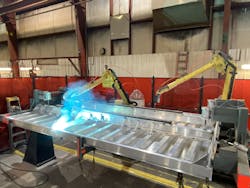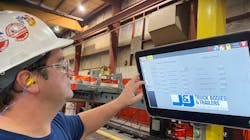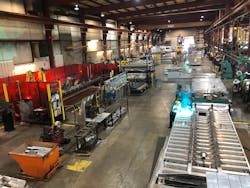In 2018, J&J Truck Bodies & Trailers was struggling to find and retain skilled workers—a problem common to most manufacturers during the long, steady recovery from the Great Recession. And, with business going strong, company President Michael Riggs also recognized the need to improve production efficiency at the Somerset, Pa., facility.
Today, some three years after making the decision to install a robotic welder for its aluminum truck bodies, Riggs reports that the million-dollar investment is paying for itself in labor savings and improved throughput.
But the payoff didn’t come quickly or easily. Essentially, the system didn’t perform nearly as well when it was installed on the shop floor as it had during the set up and demonstration period at the robotics integrator facility.
“You're talking about a million dollar-plus capital investment with that machine sitting and not producing, and having to wait for a week or two at a time to get somebody on site,” Riggs said.
J&J Robotics Manager Brian Kreger concedes that setting up the system was “a struggle,” taking nearly four months from installation to regular production.
“In the beginning, we had some trouble. Our programming was done and everything was set and supposed to work,” Kreger said. “Instead of modelling every understructure, our parametric programming directs the robot based on where the understructure should be; and then we're using touch sensing to put the weld in the right location. But our welds were off.
“So we had months of trying to get it to weld in the right place. Granted, if we were just welding the same part over and over again, it wouldn't have been a problem. But the way we were calculating everything, it just wasn't adding up correctly for the robot.”
Kreger credits Riggs with staying the course—and with convincing the board of directors to keep writing checks.
But Kreger knew the potential for the system to improve operations at J&J. In fact, an informal conversation with Riggs about welding robots grew into a more detailed plan—and Riggs convinced Kreger to join J&J to see it through.
That system, which includes two programmable Fanuc robot welding stations, is unique in the truck body space, suggests Kreger—who has 25 years of experience in robotics.
Indeed, the “parametric” programming is the key to being able weld the underbodies and sides for the range of J&J bodies.
“Every understructure is a snowflake,” Kreger said. “Every understructure, every side—every truck—is its own program for different lengths, crossmembers, and spacing.”
Of course, truck body manufacturers having been using robots for years.
“What makes our system newsworthy is we are able, via parametric 3-D modeling and then parametric robotic programming, to add variables into the program that allows us to weld from 11 feet to 20 feet and add 13 different variables into that program that the robot is capable of handling,” Riggs said. “There's a lot of robots out in the world that do the same thing over and over and over again; we have another 25-year-old system that does that. But what makes this unique is the parametric modeling and the program that actually gives you the ability to create variety on the fly.”
The basics
The welding cell takes up about 60 feet on the production line, and replaced a paint booth on the floor.
“We moved things around; we changed the way material flows through the shop,” Kreger said.
By July 2020, the system was welding the 11-foot bodies for J&J’s PennDOT orders, with DelDOT underbodies added in January 2021 and followed by the PennDOT 13'-6" underbodies.
Recognizing that a single station could keep up with underbody production, in December 2019 Kreger and the J&J team began work on the sides, designing the tooling and undertaking programming for the second station. Production began in June 2020.
“Once the sides came online with the robot, we were able to move our Gullco seam welder up to our trailer plant campus and redeploy it to build trailers versus just dump body sides,” Riggs added. “So instead of having two separate stations for underbody and sides, now we have one robotic cell with two stations in line that does both the underbody and the sides all in that same 60-foot footprint.”
In its first year of operation the robotic welder produced 111 underbodies and 215 sets of sides.
Benefits
Now that the system is dialed in, the robots need little supervision during the two- or three-hour run time. So, at the end of the dayshift, the operator will position an underbody, set the program, and initiate the job. The skeleton night crew simply keeps an eye on the process as they go about their regular chores.
And maintaining the robots has been straightforward, with operators giving the system a once-over before and after each shift. Additionally, Riggs points out that the robot can be programmed to take care of the itself, such as a self-cleaning routine.
“Like with nozzle cleaning, where a lot of times men and women have a tendency to run it until something's broken,” he said. “The nice thing about the robot is, after it welds for so long, it's programmed to automatically do some preventative maintenance on itself, which prolongs the life of tips, for instance.”
But the bottom line is that the robots are saving five hours of labor per understructure, and two hours of labor for each set of sides—for an average labor savings of seven hours per aluminum body.
“That cell was originally staffed with five people; were able to move two people up in production,” Riggs added. “Not only do we get the labor savings per body, but we get increased throughput on the front side of the robot.”
The J&J way
While the operators undertake a basic Fanuc course and then work with Kreger to get up to speed on the robots, uniquely, the training at J&J goes both ways.
Early on, as the bugs were being worked out, the workforce had an “adverse reaction” to the system, Riggs recalls. Basically, the robots weren’t as good they are.
“It took close to a year to get people to accept the automation, because these guys are pretty proud; our aluminum finish welders are phenomenal,” Riggs said. “The idea that you can have a machine that can produce the same type of quality was an obstacle to overcome.”
So, in a nod to the human welders’ skill, the robots have been programmed to mimic them.
“We could make it weld faster and smoother, but we chose to mimic the kind of welding we've done in the past.”
In turn, the robots have helped J&J tighten tolerances and also improve consistency because they “never get tired.”
“We’re trying to grab all of that knowledge from the guys on the floor, who have been doing it forever, and automate it as much as we can,” Kreger said.
But Riggs and Kreger emphasize that the robots have not taken away jobs from human welders. On the contrary, much of the work now done by the robots is uncomplicated and repetitive, and had been assigned to the least experienced workers. Now those workers get to do more challenging work—although, Riggs notes, beginning welders are still assigned jobs on the body where the welds of a less-expert hand won’t be visible.
The most experienced welders now can work exclusively on final body weld-out tasks.
Lessons learned
So, based on the experience over the last three years, is J&J looking for additional opportunities to automate?
“We have all kinds of dreams,” Riggs said with a laugh. “Automated blasting is one of the systems that we're looking at. It's not as complex as what we're doing with the welding robots, especially with the parametric welding. Blasting is more of an envelope; it's more forgiving.
“We’ve also looked at the same type of system and in our trailer manufacturing. The challenge that we have there right now is we don't have the volume to support the ROI presently—it’s just a smaller component of our business.”
The good news is that J&J tackled a difficult challenge early, and learned from the experience.
More broadly, J&J would approach the project differently with their suppliers.
“If we would have understood the challenges that we had standing the system up, I think we would have more time with laying out the level of support that we expected and what they could provide,” Riggs said. “Having those learned those lessons, the next time that we would buy a system we would spend a lot more time laying out expectations, and negotiating post-sale support.”
And having someone in-house who can shepherd the project from start to finish is critical.
“Brian is kind of the key. He is the reason that our program is successful,” Riggs said. “Without him, it would have been a failed experiment, I believe.”
Kreger returns the compliment.
“But without a company willing to invest in this and having a vision to see this through, it can’t succeed,” Kreger said. “The ownership’s got be positive—always looking down the road, seeing that light at the end of the tunnel.
“It takes a lot of good people to make this work.”
About the Author
Kevin Jones
Editor
Kevin has served as editor-in-chief of Trailer/Body Builders magazine since 2017—just the third editor in the magazine’s 60 years. He is also editorial director for Endeavor Business Media’s Commercial Vehicle group, which includes FleetOwner, Bulk Transporter, Refrigerated Transporter, American Trucker, and Fleet Maintenance magazines and websites.
Working from Beaufort, S.C., Kevin has covered trucking and manufacturing for nearly 20 years. His writing and commentary about the trucking industry and, previously, business and government, has been recognized with numerous state, regional, and national journalism awards.




